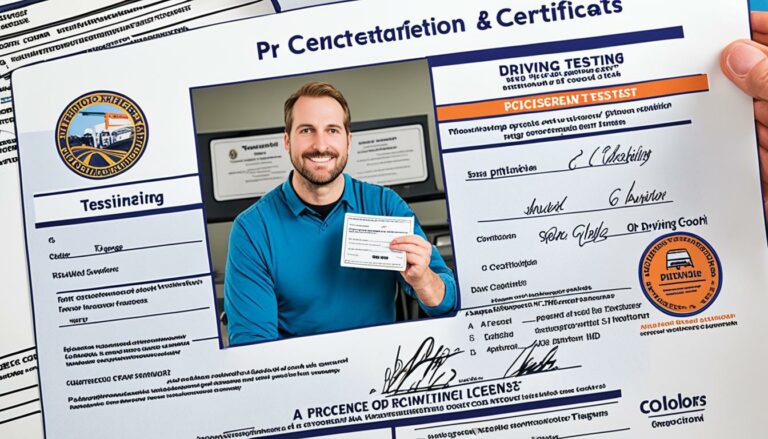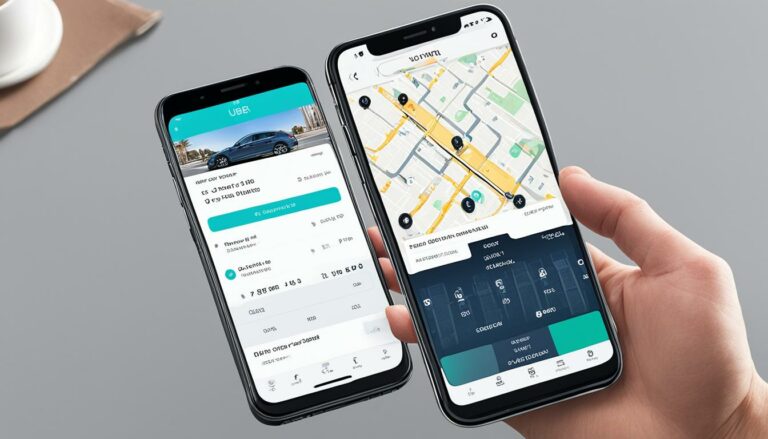Can 15 Year Olds Drive? Age-Specific Guidelines
In the United States, there are specific guidelines and restrictions when it comes to 15 year olds and driving. While they may not be able to get a full driver’s license just yet, there are opportunities for them to gain driving experience under certain conditions. Let’s explore the rules and requirements for 15 year old drivers in more detail.
Key Takeaways:
- 15 year olds can obtain a provisional instruction permit, allowing them to practice driving under the supervision of a licensed adult.
- Requirements for obtaining the permit include completing a driver license application, having parents or guardians sign the form, presenting necessary identification documents, providing proof of completion of driver education or enrollment in a driver training program, passing a knowledge test, and paying the required fees.
- Once 16 years old, they can apply for a driver’s license by fulfilling additional requirements such as holding the instruction permit for at least 6 months, completing driver education and training, obtaining signatures from parents or guardians verifying driving practice hours, scheduling and passing a driving test, and paying the necessary fees.
- During the first 12 months of having a driver’s license, 15 year olds are subject to restrictions such as limited nighttime driving and passenger restrictions.
- It is essential for young drivers to practice safe driving habits, including being aware of their surroundings, sharing the road responsibly, and knowing how to handle different driving conditions and emergency situations.
Obtaining a Driver’s License
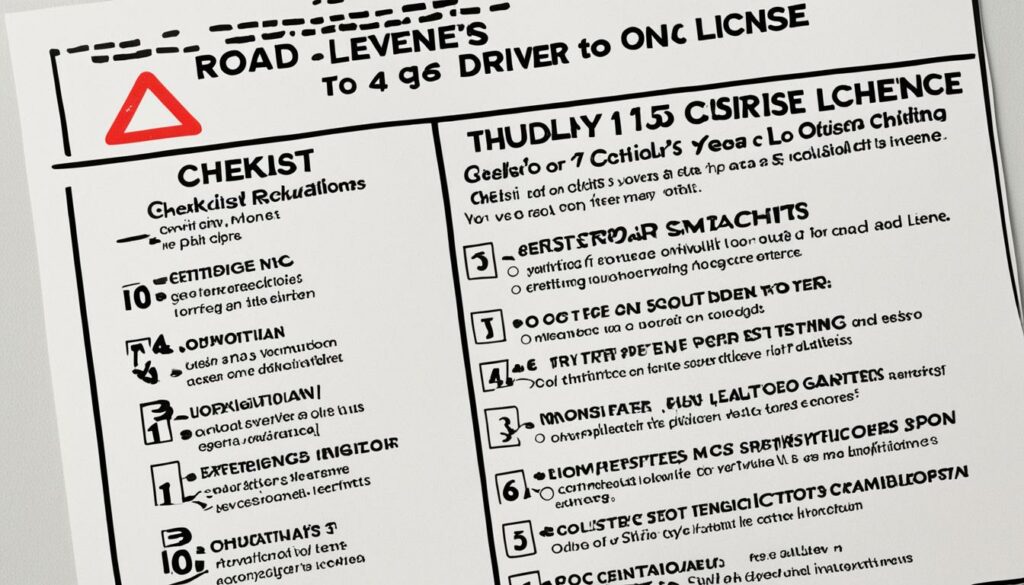
Obtaining a driver’s license is an important milestone for 15 year olds who are eager to hit the road. However, there are various requirements and steps that must be followed in order to obtain a driver’s license in the United States.
First and foremost, individuals must be at least 16 years old to apply for a driver’s license. Additionally, they must have held their instruction permit for a minimum of 6 months before being eligible to apply for a license.
In order to apply for a provisional license, individuals will need to provide proof of completion of a driver education program. This can be obtained through a school or a driving school. Additionally, they will also need to complete a driver training program, which includes both classroom instruction and on-road practice.
One of the important requirements is to obtain signatures from parents or guardians verifying that the individual has completed 50 hours of driving practice, including 10 hours of night driving. This is to ensure that novice drivers have enough practice and experience before being granted a full driver’s license.
Once all the necessary requirements are met, individuals can schedule a driving test. This test assesses their ability to safely operate a vehicle and follow traffic rules. Passing the driving test is crucial in obtaining a driver’s license.
Finally, individuals must pay the necessary fees associated with obtaining a driver’s license. These fees may vary depending on the state and jurisdiction.
It is important for 15 year olds and their parents or guardians to familiarize themselves with the specific driver’s license requirements in their state or jurisdiction. By understanding and adhering to these requirements, young drivers can navigate through the process and obtain their driver’s license in a safe and responsible manner.
Now that we’ve explored the requirements for obtaining a driver’s license, let’s move on to the next section, where we will discuss the driving restrictions that 15 year olds must abide by.
Driving Restrictions for 15 Year Olds

During the first 12 months of having a driver’s license, 15 year olds face important driving restrictions. These restrictions are in place to ensure the safety of young drivers and others on the road.
Nighttime Driving Restrictions
One of the key driving restrictions for 15 year olds is the limitation on nighttime driving. They are not allowed to drive between 11 p.m. and 5 a.m. unless accompanied by a licensed adult. Exceptions to this rule include situations involving medical emergencies or school and employment activities.
Passenger Restrictions
Another restriction for 15 year olds is the limitation on passenger transport. They are prohibited from transporting passengers under the age of 20 unless accompanied by a licensed adult in the vehicle. This restriction helps minimize distractions and potential risks associated with having young passengers in the car.
Cell Phone Use While Driving
In addition to nighttime driving and passenger restrictions, 15 year olds are also prohibited from using cell phones or other electronic communication devices while driving, except for emergency calls or when driving on private property. This restriction aims to prevent distractions and promote focused driving.
By adhering to these driving restrictions, 15 year olds can develop safe driving habits, gain valuable experience, and contribute to road safety. It is important for young drivers to understand and follow these limitations to ensure their own well-being and the well-being of others on the road.
Safety Tips for Young Drivers
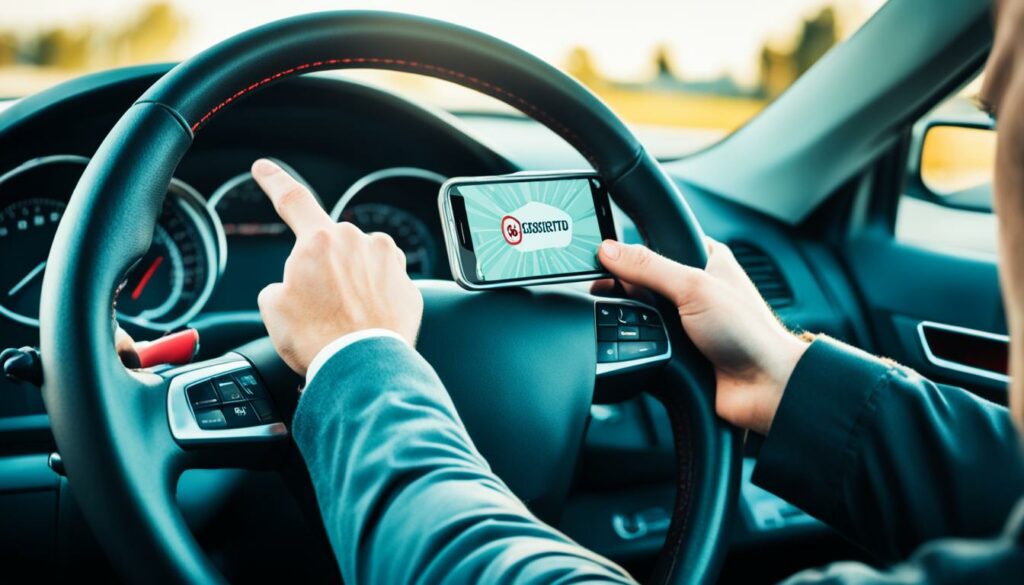
Ensuring the safety of young drivers is paramount when they are on the road. It is crucial for them to be aware of their surroundings and maintain safe driving habits. Here are some essential tips for young drivers to drive safely:
Sharing the Road with Motorcycles and Bicycles
When sharing the road with motorcycles and bicycles, young drivers should exercise extra caution. Always check for approaching motorcycles and bicycles before changing lanes or making turns. Be aware of their smaller size and avoid following too closely. Remember to check blind spots carefully, as motorcycles and bicycles can easily go unnoticed.
School Bus Safety
Interacting safely with school buses is essential to protect the well-being of young passengers. Always come to a complete stop when the bus’s red lights are flashing and the stop sign is extended. Maintain a safe distance from the bus and be patient while children are boarding or exiting. Following these guidelines will help ensure the safety of everyone on the road.
Railroad Crossing Safety
Approaching railroad crossings requires special attention from young drivers. Always approach a railroad crossing with caution and be prepared to stop if necessary. Look both ways to ensure there are no oncoming trains before proceeding. Never attempt to beat a train or drive around lowered gates. Respecting railroad crossing safety guidelines is crucial for preventing accidents.
By following these safety tips, young drivers can contribute to a safer driving environment for everyone on the road. Their awareness and responsible actions are vital in preventing accidents and maintaining road safety.
Handling Different Driving Conditions
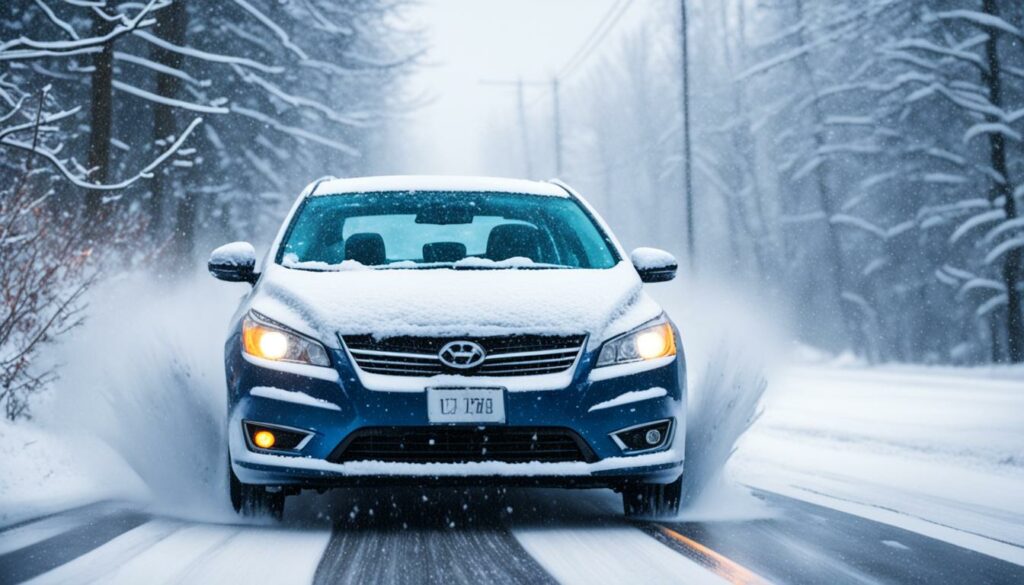
Young drivers need to be prepared to adapt their driving skills to various weather and road conditions. Different driving conditions require different strategies to ensure safety on the road.
Foggy Conditions
When driving in foggy conditions, it’s important to take extra precautions. Here are some tips:
- Use low-beam headlights to improve visibility.
- Increase your following distance to allow for more reaction time.
By following these tips, you can navigate through foggy conditions safely and effectively.
Driving in Heavy Rain or Snow
Heavy rain or snow can significantly impact driving conditions. To stay safe, consider the following:
- Reduce your speed to adjust for the slippery road surface.
- Use windshield wipers and defroster as needed to maintain visibility.
- If driving in snow, carry chains for added traction.
Driving on Slippery Roads
Slippery roads can pose a challenge to drivers. To ensure safety, keep these tips in mind:
- Drive more slowly than usual to compensate for reduced traction.
- Maintain a safe distance from the vehicle in front of you to allow for ample stopping time.
- Avoid sudden stops and fast turns to prevent skidding.
Driving in Windy Conditions
Windy conditions can make driving more difficult. Stay safe with these recommendations:
- Drive at a slower speed to maintain better control of your vehicle.
- Grip the steering wheel firmly to compensate for strong wind gusts.
- Be prepared to correct your steering as the wind force changes.
Adapting your driving to different conditions is essential for safe and confident driving. By following these tips, young drivers can navigate through fog, heavy rain or snow, slippery roads, and windy conditions with caution and ease.
Dealing with Emergency Situations

As young drivers, it’s essential to know how to handle emergency situations on the road. Being prepared can make a significant difference in ensuring your safety and the safety of others. Here are some important tips to remember:
Handling Collisions
If you find yourself in a collision, it’s crucial to follow the appropriate steps. For guidance, refer to the California Driver Handbook, which provides instructions for both witnesses and those involved in the accident.
Responding to Emergency Vehicles
When emergency vehicles approach with their sirens on, it’s important to react calmly and swiftly. Safely pull over to the right side of the road, allowing them to pass without obstructing their path. Avoid stopping in the middle of an intersection, as this can impede the progress of emergency vehicles.
What to Do in Case of Brake Failure or Tire Blowout
Experiencing brake failure or a tire blowout can be frightening, but knowing what to do can help you stay safe. In the event of brake failure, downshift into a lower gear, apply the parking brake gradually, steer into bushes or something soft, sound the horn, and flash the lights to warn other drivers. If a tire blows out, hold the steering wheel tightly, slow down gradually, guide the vehicle off the road, and apply the brakes gently when the vehicle is almost stopped.
Driving in Extreme Heat
Extreme heat can pose challenges for both you and your vehicle. To navigate these conditions safely, keep these tips in mind: watch the vehicle’s temperature gauge, avoid high-speed driving, use low gears when moving slowly in traffic, and if your engine is overheating, turn off the air conditioning. Staying aware of your vehicle’s temperature can prevent potential breakdowns in hot weather.
By familiarizing yourself with these emergency situations and knowing how to respond, you’ll be better equipped to handle unexpected challenges on the road. Stay calm, follow the necessary steps, and prioritize the safety of yourself and others.
Safety Measures for Challenging Road Conditions

Young drivers need to be well-prepared to drive safely in challenging road conditions. Whether it’s preventing hydroplaning, navigating through snow or mud, or driving on slippery roads, knowing the right safety measures can make all the difference in staying safe on the road.
1. Preventing Hydroplaning
Hydroplaning can occur when your vehicle loses traction on a wet surface and starts to slide uncontrollably. To prevent hydroplaning:
- Drive at a slower speed, especially during rainy conditions.
- Maintain good tire tread to ensure better grip on the road.
- Keep your tires properly inflated to promote better traction.
- Steer around water if possible, especially if you’re unsure of its depth.
- Slow down when changing directions or if you start to hear sloshing sounds, indicating standing water on the road.
2. Driving on Snow or Mud
Driving on snow or mud can present its own set of challenges. Here are some safety tips to keep in mind:
- Shift into a low gear to maintain better control and avoid spinning your wheels.
- Avoid sudden acceleration or braking, as it can cause your tires to lose traction.
- If your vehicle gets stuck, try a forward-backward motion to free it.
3. Driving on Slippery Roads
Slippery roads, whether due to rain, ice, or other factors, require extra caution. Consider the following safety measures:
- Drive at a slower speed than usual, giving yourself plenty of time to react to any unexpected situations.
- Maintain a greater distance between your vehicle and the one ahead to allow for more stopping time.
- Avoid sudden stops or quick turns, as these can cause your tires to lose traction.
- Be especially cautious around known slippery areas, such as ice patches and deep puddles.
By implementing these safety measures, young drivers can navigate through challenging road conditions with confidence and reduce the risk of accidents. Remember, it’s always better to prioritize safety over speed when faced with adverse weather or road conditions.
Handling Vehicle Malfunctions
Young drivers should be prepared to handle various vehicle malfunctions that can occur on the road. Knowing how to respond to these situations can help ensure both their safety and the safety of others. In this section, we will discuss three common vehicle malfunctions and the appropriate actions to take.
Dealing with a Stuck Accelerator
If you find yourself in a situation where the accelerator of your vehicle gets stuck, remain calm and follow these steps:
- Shift into neutral: Quickly shift the gear into neutral to disengage the engine power.
- Apply the brakes and steer straight: Use firm pressure on the brakes to slow down the vehicle. Steer in a straight line to maintain control.
- Warn other drivers: Activate your hazard lights and use the horn to alert other drivers of the situation.
- Drive off the road safely: Look for a safe spot to pull over and bring the vehicle to a complete stop. Turn off the engine and contact for assistance if needed.
By following these steps, you can effectively handle a stuck accelerator and prevent any potential accidents.
Responding to Brake Failure
In the event of brake failure, it is crucial to act quickly and take the following measures:
- Downshift: Shift to a lower gear to help slow down the vehicle.
- Apply the parking brake: Gradually apply the parking brake to help stop the vehicle.
- Steer into something soft: Look for a safe area such as an open field or bushes to steer into, which can help slow down the vehicle further.
- Sound the horn: Alert other drivers by sounding the horn to indicate your presence.
- Turn off the ignition: Once the vehicle has come to a stop, turn off the ignition to prevent further damage or accidents.
Remember, staying calm and taking these steps can help you safely manage a brake failure situation.
Extreme Cold Driving Precautions
Driving in extreme cold conditions requires additional precautions to ensure your safety. Here are some important tips to follow:
- Watch the vehicle’s temperature gauge: Keep an eye on the temperature gauge to prevent overheating.
- Avoid high-speed driving: Reduce your speed to maintain better control of the vehicle.
- Use low gears in slow-moving traffic: Shift to lower gears when driving in slow-moving traffic to prevent stalling and improve traction.
- Start the engine to prevent overheating: If you need to idle your vehicle for an extended period in extreme cold, periodically start the engine to prevent it from overheating.
Following these precautions can help you navigate through extreme cold situations while minimizing the risks associated with such conditions.
| Vehicle Malfunction | Actions to Take |
|---|---|
| Stuck Accelerator | 1. Shift into neutral 2. Apply brakes and steer straight 3. Warn other drivers 4. Drive off the road safely |
| Brake Failure | 1. Downshift 2. Apply parking brake 3. Steer into something soft 4. Sound the horn 5. Turn off the ignition |
| Extreme Cold Driving | 1. Watch the temperature gauge 2. Avoid high-speed driving 3. Use low gears in slow-moving traffic 4. Start the engine to prevent overheating |
Graduated Driver License Program
Many states, including California, have implemented a graduated driver license (GDL) program to ensure the safe and gradual progression of young drivers towards obtaining a full driver’s license. The GDL program is designed to provide age-related milestones and restrictions that help young drivers gain the necessary experience and skills before fully entering the realm of independent driving.
In California, the GDL program consists of three stages:
- Junior Permit: At the age of 15 and a half, young drivers can obtain a junior permit. To acquire this permit, they must complete a driver license application, have their parents or guardians sign the necessary forms, provide required identification documents, show proof of completion of driver education or enrollment in a driver training program, pass a knowledge test, and pay the required fees. With the junior permit, young drivers can practice driving under the supervision of a licensed adult.
- Learner’s Permit: After holding the junior permit for at least 6 months, young drivers who are at least 16 years old can apply for a learner’s permit. To obtain the learner’s permit, they must provide proof of completion of driver education and driver training, obtain signatures from their parents or guardians verifying 50 hours of practice driving (including 10 hours of night driving), schedule and pass a driving test, and pay the necessary fees.
- Provisional License: Once young drivers have held their learner’s permit for at least 6 months and are at least 16 years and 6 months old, they can apply for a provisional license. The provisional license allows young drivers more freedom and independence on the road but still comes with certain restrictions, such as nighttime driving limitations and passenger restrictions.
The GDL program ensures that young drivers progress through these stages, gaining experience and responsibility at each step of the process. By following the GDL requirements, young drivers can develop their driving skills and knowledge over time, leading to safer driving practices.
With the GDL program in place, young drivers have the opportunity to gradually transition into independent drivers, mitigating the risks associated with inexperienced and immature driving behaviors. This structured approach to licensing for young drivers promotes road safety and instills responsible driving habits from the beginning of their driving journey.
Benefits of the GDL System
The Graduated Driver License (GDL) program offers numerous benefits for young and new drivers, promoting safer driving practices and reducing the risks associated with inexperienced drivers. By providing a structured learning process, the GDL system prepares young drivers for the responsibilities of being behind the wheel, allowing them to gain necessary experience and knowledge.
One of the key benefits of the GDL system is its emphasis on gradual progression. Rather than granting full driving privileges immediately, the program introduces young drivers to driving responsibilities in a controlled environment. This approach allows them to develop crucial skills incrementally, ensuring a solid foundation for safe driving habits.
The GDL system also instills good driving habits by imposing restrictions and limitations during the initial stages. These restrictions, such as nighttime driving limitations and passenger restrictions, aim to minimize potentially dangerous situations and promote responsible driving behaviors. By gradually easing these restrictions as young drivers gain experience, the program encourages responsible decision-making on the road.
“The GDL system provides young drivers with a step-by-step framework for learning and practicing safe driving habits, helping them build confidence and competence behind the wheel.”– David Johnson, Department of Motor Vehicles
Furthermore, the GDL program prepares young drivers for the challenges they may encounter on the road. Through mandatory driver education and training programs, they receive comprehensive instruction on various aspects of driving, including defensive driving techniques, road sign recognition, and handling emergency situations. This knowledge equips them to make informed and safe decisions while driving.
The GDL system also promotes safer driving by enabling young drivers to become more familiar with their geographical area. Gradual progression within the program encourages young drivers to practice in a range of driving conditions, including familiar and unfamiliar routes. This exposure helps them develop adaptability, confidence, and an understanding of hazards specific to their local area.
In summary, the Graduated Driver License program offers multiple benefits for young and new drivers. By providing a structured and controlled environment for learning, it helps reduce the risks associated with inexperienced drivers. The program promotes safer driving habits, prepares young drivers for the challenges they may face on the road, and instills the skills and knowledge necessary for a lifetime of responsible driving.
| Benefits of the GDL System |
|---|
| Reduces risks associated with inexperienced drivers |
| Provides a structured learning process |
| Gradual progression and introduction of responsibilities |
| Instills good driving habits |
| Prepares for challenges on the road |
| Encourages familiarity with geographical area |
Conclusion
After going through the various stages of the Graduated Driver License (GDL) system, 15 year olds can obtain driving privileges. It is essential for young drivers to familiarize themselves with the age-specific guidelines and restrictions in order to ensure their safety, as well as the safety of others on the road. The GDL system offers a progressive approach, allowing young drivers to gradually develop the necessary skills and experience before obtaining their full driver’s license.
By following the GDL guidelines, 15 year olds can improve their driving abilities and become responsible drivers. The system sets age-related milestones and provides restrictions that help young drivers navigate the complexities of the road in a controlled manner. This ensures that they acquire the experience needed to handle different situations confidently.
Driving privileges for 15 year olds are an important step towards independence and adulthood. Through the GDL system, they can gain valuable on-road experience while adhering to specific limitations designed to keep them safe. By responsibly following the guidelines set forth, young drivers can lay a solid foundation for a lifetime of safe driving.
FAQ
Can 15 year olds drive?
Yes, 15 year olds can obtain driving privileges through the graduated driver license (GDL) system.
What are the age-specific guidelines for 15 year old drivers?
15 year olds can obtain a provisional instruction permit, which allows for practice driving under the supervision of a licensed adult.
What are the requirements for obtaining a driver’s license?
To obtain a driver’s license, individuals must be at least 16 years old, have held their instruction permit for at least 6 months, provide proof of completion of driver education and driver training, schedule and pass a driving test, and pay the necessary fees.
What are the driving restrictions for 15 year olds?
During the first 12 months of having a driver’s license, 15 year olds are prohibited from driving between 11 p.m. and 5 a.m. without a licensed adult present, and they are not allowed to transport passengers under 20 years old unless accompanied by a licensed adult.
What safety tips should young drivers follow?
Young drivers should be aware of their surroundings, check for approaching vehicles, know how to interact with school buses and railroad crossings, and practice safe driving habits in different weather conditions.
How should young drivers handle different driving conditions?
Young drivers should adjust their driving in foggy conditions, heavy rain or snow, on slippery roads, and in windy conditions to ensure their safety.
What should young drivers do in emergency situations?
Young drivers should know how to respond in the event of a collision, when emergency vehicles approach, in case of brake failure or tire blowout, and when driving in extreme heat.
How can young drivers navigate challenging road conditions?
Young drivers should follow safety measures to prevent hydroplaning, drive on snow or mud, and navigate slippery roads to avoid accidents.
How should young drivers handle vehicle malfunctions?
Young drivers should know how to respond if the accelerator gets stuck, brakes fail, or if they encounter extreme cold conditions while driving.
What is the graduated driver license program?
The graduated driver license (GDL) program is a system that provides milestones and restrictions based on age and experience to help young drivers gain the necessary skills and experience before obtaining a full driver’s license.
What are the benefits of the GDL system?
The GDL system helps reduce the risks associated with driving by gradually introducing young and new drivers to the responsibilities of driving, ensuring they gain experience and knowledge to drive safely, and instilling good driving habits.
What are the driving privileges for 15 year olds?
15 year olds can obtain driving privileges through the various stages of the GDL system, allowing them to gradually progress towards obtaining a full driver’s license.





